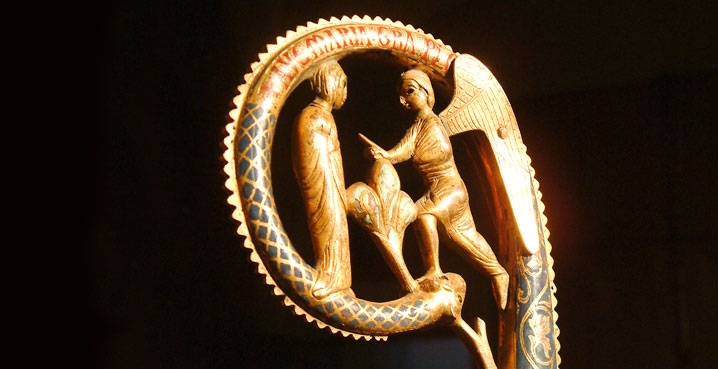The abbots of Solesmes
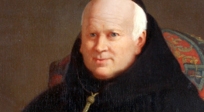
Dom Prosper GUERANGER
Dom Prosper Guéranger restored monastic life at Solesmes in 1833. He was born in Sablé on 4 April 1805 and hence knew Solesmes well.
He went to seminary in Le Mans, was ordained to the priesthood in 1827 and was fascinated by Church history. Guéranger’s desire to lead monastic life was first sparked by discovering a historical period when monasticism had flourished and by coming into contact with the great works published by the Maurists. When in 1831 he heard that the priory of Solesmes was about to be demolished, he thought of buying it himself to live Benedictine life there. Helped by some friends and encouraged by his bishop, he scraped together enough money to rent the monastery and moved in with three companions on 11 July 1833. The small community was penniless, lacked prestige to attract vocations and, above all, had no experience of monastic life. Guéranger was its superior for twenty-eight years even though he had never received a monastic formation. Had the undertaking not been an act of faith, it would have been utter madness. But the young Prior Guéranger had a very sound sense for all things Benedictine, for the liturgy, and for the spiritual life. He was therefore a living example for his monks.
The Holy See recognized the authentic Benedictine nature of the Solesmes community in 1837, erecting the small priory as an abbey and appointing Guéranger as head of the French Congregation of the Order of St Benedict, which was established by the same decree. A few days later, Dom Guéranger made his solemn profession between the hands of the abbot of St Paul-outside-the Walls in Rome on 26 July.
Helped by Cécile Bruyère, Dom Guéranger founded the Abbey of Sainte-Cécile, near the Abbey of Saint-Pierre de Solesmes, in 1866. This monastery went on to make foundations, thus resulting in the female branch of the Solesmes Congregation.
Guéranger's daily teaching and many publications were inspired by contemplating the mystery of the Incarnation. The liturgy was a special focus for his attention. He explained liturgical spirituality to the Christian people in The Liturgical Year, which is his most famous book. He also published Institutions Liturgiques, setting out the relationship between the liturgy and the Church's faith and unity. With this book, Dom Guéranger helped France’s dioceses return to the Roman liturgy.
Dom Guéranger had a special love for the papacy. His Mémoire sur l'Immaculée Conception (On the Immaculate Conception) drew the attention of Pope Pius IX, who asked him to help prepare this Marian dogma, which was proclaimed on 8 December 1854. At the First Vatican Council in 1870, Guéranger set out the Patristic witness in support of the Roman Pontiff’s infallibility.
Guéranger also had a great devotion to the Sacred Heart, which he regarded as the best remedy against Jansenism and was one of the reasons for his interest in St Gertrude and other mystical authors.
At Dom Guéranger’s initiative from 1862 onwards, some of his disciples were sent out to look for the sources of the Church's liturgical chant, thus setting Solesmes on a path that would lead to the restoration of Gregorian chant and the publication of its repertoire.
He died on 30 January 1875 at the age of 69. His body is buried in the crypt of our abbey church and his heart lies in the sanctuary of the church at Sainte-Cécile de Solesmes.
Several biographies of Dom Guéranger have been written: by Dom Delatte, by Dom Louis Soltner, and finally by Dom Guy Oury.
Prayer for the Beatification of Dom Prosper Guéranger:
God our Father, your servant Dom Prosper Guéranger, Abbot of Solesmes, guided by the Holy Spirit, helped a multitude of your faithful people rediscover the meaning of the liturgy as the source of true Christian life. May his devotion to your Holy Church
and his filial love for the Immaculate Virgin, inspired by the mystery of the Incarnate Word, be a light for Christians of our own day. Deign, O Lord, to grant the favour we ask you by his intercession, so that his sanctity may be recognized by all and that the Church may soon allow us to invoke him as the one of your blessed and one of your saints. Through Jesus Christ, Our Lord. Amen.
Dom Prosper GUERANGER
Dom Prosper Guéranger restored monastic life at Solesmes in 1833. He was born in Sablé on 4 April 1805 and hence knew Solesmes well.
He went to seminary in Le Mans, was ordained to the priesthood in 1827 and was fascinated by Church history. Guéranger’s desire to lead monastic life was first sparked by discovering a historical period when monasticism had flourished and by coming into contact with the great works published by the Maurists. When in 1831 he heard that the priory of Solesmes was about to be demolished, he thought of buying it himself to live Benedictine life there. Helped by some friends and encouraged by his bishop, he scraped together enough money to rent the monastery and moved in with three companions on 11 July 1833. The small community was penniless, lacked prestige to attract vocations and, above all, had no experience of monastic life. Guéranger was its superior for twenty-eight years even though he had never received a monastic formation. Had the undertaking not been an act of faith, it would have been utter madness. But the young Prior Guéranger had a very sound sense for all things Benedictine, for the liturgy, and for the spiritual life. He was therefore a living example for his monks.
The Holy See recognized the authentic Benedictine nature of the Solesmes community in 1837, erecting the small priory as an abbey and appointing Guéranger as head of the French Congregation of the Order of St Benedict, which was established by the same decree. A few days later, Dom Guéranger made his solemn profession between the hands of the abbot of St Paul-outside-the Walls in Rome on 26 July.
Helped by Cécile Bruyère, Dom Guéranger founded the Abbey of Sainte-Cécile, near the Abbey of Saint-Pierre de Solesmes, in 1866. This monastery went on to make foundations, thus resulting in the female branch of the Solesmes Congregation.
Guéranger's daily teaching and many publications were inspired by contemplating the mystery of the Incarnation. The liturgy was a special focus for his attention. He explained liturgical spirituality to the Christian people in The Liturgical Year, which is his most famous book. He also published Institutions Liturgiques, setting out the relationship between the liturgy and the Church's faith and unity. With this book, Dom Guéranger helped France’s dioceses return to the Roman liturgy.
Dom Guéranger had a special love for the papacy. His Mémoire sur l'Immaculée Conception (On the Immaculate Conception) drew the attention of Pope Pius IX, who asked him to help prepare this Marian dogma, which was proclaimed on 8 December 1854. At the First Vatican Council in 1870, Guéranger set out the Patristic witness in support of the Roman Pontiff’s infallibility.
Guéranger also had a great devotion to the Sacred Heart, which he regarded as the best remedy against Jansenism and was one of the reasons for his interest in St Gertrude and other mystical authors.
At Dom Guéranger’s initiative from 1862 onwards, some of his disciples were sent out to look for the sources of the Church's liturgical chant, thus setting Solesmes on a path that would lead to the restoration of Gregorian chant and the publication of its repertoire.
He died on 30 January 1875 at the age of 69. His body is buried in the crypt of our abbey church and his heart lies in the sanctuary of the church at Sainte-Cécile de Solesmes.
Several biographies of Dom Guéranger have been written: by Dom Delatte, by Dom Louis Soltner, and finally by Dom Guy Oury.
Prayer for the Beatification of Dom Prosper Guéranger:
God our Father, your servant Dom Prosper Guéranger, Abbot of Solesmes, guided by the Holy Spirit, helped a multitude of your faithful people rediscover the meaning of the liturgy as the source of true Christian life. May his devotion to your Holy Church
and his filial love for the Immaculate Virgin, inspired by the mystery of the Incarnate Word, be a light for Christians of our own day. Deign, O Lord, to grant the favour we ask you by his intercession, so that his sanctity may be recognized by all and that the Church may soon allow us to invoke him as the one of your blessed and one of your saints. Through Jesus Christ, Our Lord. Amen.
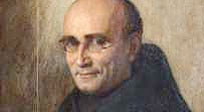
Dom Charles COUTURIER
Born in 1817, was prior, i.e. second-in-command to the abbot, when Dom Guéranger died; he was elected to succeed him on 11 February 1875. This good and prudent man’s abbacy got off to an auspicious start at Solesmes; the monastery’s sole concern was to ensure its founder’s heritage bore fruit. But from 1879 onwards, the French government embarked on a resolutely anti-clerical policy. On 6 November 1880, the monks of Solesmes were expelled from their monastery by the police.
During fifteen or so years of alternating soft and hard stances towards the monks from the authorities, the Benedictines of Solesmes lived locked out of their monastery and celebrated their offices in the parish church or at Sainte-Cécile. They were scattered across twenty or so houses placed at their disposal in the village and surrounding area. God's abundant grace helped maintain their fervour despite such unusual living conditions. This trial strengthened their unity of heart, attracted vocations and even encouraged foundations: in 1889, the monastery of Saint-Paul was established in Wisques, near Sainte-Cécile's foundation of Notre-Dame de Wisques. In 1890, a group of monks took over the monastery of Saint-Maur in Anjou.
Dom Couturier died on 29 October 1890, in the house where he had taken refuge in Solesmes village. This situation was the exact opposite of the abbatial motto he had chosen: Consortia tecta (Shared beneath One Roof)! This formula is taken from Virgil's Georgics, where it evokes bees gathered together in a single hive. It proves that Abbot Couturier held nothing dearer than the unity of his community under the same roof. His coat of arms depicted a beehive.
Dom Charles COUTURIER
Born in 1817, was prior, i.e. second-in-command to the abbot, when Dom Guéranger died; he was elected to succeed him on 11 February 1875. This good and prudent man’s abbacy got off to an auspicious start at Solesmes; the monastery’s sole concern was to ensure its founder’s heritage bore fruit. But from 1879 onwards, the French government embarked on a resolutely anti-clerical policy. On 6 November 1880, the monks of Solesmes were expelled from their monastery by the police.
During fifteen or so years of alternating soft and hard stances towards the monks from the authorities, the Benedictines of Solesmes lived locked out of their monastery and celebrated their offices in the parish church or at Sainte-Cécile. They were scattered across twenty or so houses placed at their disposal in the village and surrounding area. God's abundant grace helped maintain their fervour despite such unusual living conditions. This trial strengthened their unity of heart, attracted vocations and even encouraged foundations: in 1889, the monastery of Saint-Paul was established in Wisques, near Sainte-Cécile's foundation of Notre-Dame de Wisques. In 1890, a group of monks took over the monastery of Saint-Maur in Anjou.
Dom Couturier died on 29 October 1890, in the house where he had taken refuge in Solesmes village. This situation was the exact opposite of the abbatial motto he had chosen: Consortia tecta (Shared beneath One Roof)! This formula is taken from Virgil's Georgics, where it evokes bees gathered together in a single hive. It proves that Abbot Couturier held nothing dearer than the unity of his community under the same roof. His coat of arms depicted a beehive.
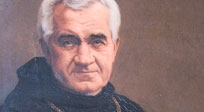
Dom Paul DELATTE
Born in 1848, was prior when Dom Couturier died. Following in his predecessors footsteps, the new abbot’s main priority was to form men seeking God. He was all too aware of the need for enclosure in any serious monastic life and was preoccupied with returning to his monastery. This was achieved on 23 August 1895, when the monastery bells rung forth once again.
But the house was now too small for the community, which had grown constantly. New buildings were therefore constructed quickly and on a grand scale. The foundation stone of the large building overlooking the River Sarthe was blessed on 21 March 1896; this building was completed in 1898. At the same time, two groups of monks were sent to make the foundations of St Michael's in Farnborough, near London (1895) and Sainte-Anne de Kergonan, near Plouharnel, Brittany in 1897.
These peaceful years ended abruptly on 1 July 1901. The law of associations, which was in fact a law against religious congregations, forced Dom Delatte and his monks into exile. With great emotion, they left Solesmes for freedom in England on 20 September 1901. Their place of exile was Appuldurcombe House, in the south of the Isle of Wight. The Juigné family bought the Abbey of Solesmes, with the intention of giving it back to the monks as soon as possible. In 1908, the community moved to the ancient site of Quarr Abbey in the north of the island, where Dom Paul Bellot built a new monastery.
The monks’ silent, peaceful exile gave them the full benefit of their abbot's teaching. They all appreciated his qualities: his brilliant mind, deep goodness combined with a delicate sensibility and, above all, his faith. Dom Delatte made a lasting, deep impression on our community. Part of his teaching was published during his lifetime in his Commentary on the Rule of St Benedict and his commentaries on Sacred Scripture: L'Évangile de Notre Seigneur (The Gospel of our Lord) and Les Épîtres de Saint-Paul (The Epistles of St Paul). Dom Delatte also published what remains an authoritative biography of Dom Guéranger.
He resigned from office in 1921 and died at Solesmes in 1937.
Dom Paul DELATTE
Born in 1848, was prior when Dom Couturier died. Following in his predecessors footsteps, the new abbot’s main priority was to form men seeking God. He was all too aware of the need for enclosure in any serious monastic life and was preoccupied with returning to his monastery. This was achieved on 23 August 1895, when the monastery bells rung forth once again.
But the house was now too small for the community, which had grown constantly. New buildings were therefore constructed quickly and on a grand scale. The foundation stone of the large building overlooking the River Sarthe was blessed on 21 March 1896; this building was completed in 1898. At the same time, two groups of monks were sent to make the foundations of St Michael's in Farnborough, near London (1895) and Sainte-Anne de Kergonan, near Plouharnel, Brittany in 1897.
These peaceful years ended abruptly on 1 July 1901. The law of associations, which was in fact a law against religious congregations, forced Dom Delatte and his monks into exile. With great emotion, they left Solesmes for freedom in England on 20 September 1901. Their place of exile was Appuldurcombe House, in the south of the Isle of Wight. The Juigné family bought the Abbey of Solesmes, with the intention of giving it back to the monks as soon as possible. In 1908, the community moved to the ancient site of Quarr Abbey in the north of the island, where Dom Paul Bellot built a new monastery.
The monks’ silent, peaceful exile gave them the full benefit of their abbot's teaching. They all appreciated his qualities: his brilliant mind, deep goodness combined with a delicate sensibility and, above all, his faith. Dom Delatte made a lasting, deep impression on our community. Part of his teaching was published during his lifetime in his Commentary on the Rule of St Benedict and his commentaries on Sacred Scripture: L'Évangile de Notre Seigneur (The Gospel of our Lord) and Les Épîtres de Saint-Paul (The Epistles of St Paul). Dom Delatte also published what remains an authoritative biography of Dom Guéranger.
He resigned from office in 1921 and died at Solesmes in 1937.
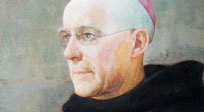
Dom Germain COZIEN
Born in 1878, was elected abbot in 1921. Judging that the political situation in France was ripe for the monks to return, he brought the community back to Solesmes the following year. Nevertheless, a group of monks was left behind at Quarr to continue monastic life there. Dom Cozien was keen to follow his predecessors’ approach to monastic life. His motto was In vinculo pacis, (In the Bond of Peace).
The Solesmes community experienced a large influx of vocations after returning to the banks of the Sarthe. Dom Bellot – the community’s architect – first undertook the necessary maintenance work after their long absence and then built the library and new cloister. Everything was ready for the Congregation's centenary, which was solemnly celebrated in 1937. Shortly afterwards, the Second World War meant there was no one left in the monastery apart from a few elderly monks and those exempt from military service. In 1940, three monks were killed at the front and several dozen were taken prisoner. Dom Cozien bore these wartime trials and the Occupation with impressive calm. When peace returned, the prisoners came back home and vigorous conventual life resumed.
Faced with swelling ranks of young monks, a decision was made in 1948 to make a new foundation in the buildings of the former abbey of Fontgombault, by the River Creuse.
Towards the end of Dom Cozien's abbacy, a new east wing was built at Solesmes, at right angles to the 19th-century building.
Dom Cozien died on 18 May 1960, less than a year after resigning as abbot.
Dom Germain COZIEN
Born in 1878, was elected abbot in 1921. Judging that the political situation in France was ripe for the monks to return, he brought the community back to Solesmes the following year. Nevertheless, a group of monks was left behind at Quarr to continue monastic life there. Dom Cozien was keen to follow his predecessors’ approach to monastic life. His motto was In vinculo pacis, (In the Bond of Peace).
The Solesmes community experienced a large influx of vocations after returning to the banks of the Sarthe. Dom Bellot – the community’s architect – first undertook the necessary maintenance work after their long absence and then built the library and new cloister. Everything was ready for the Congregation's centenary, which was solemnly celebrated in 1937. Shortly afterwards, the Second World War meant there was no one left in the monastery apart from a few elderly monks and those exempt from military service. In 1940, three monks were killed at the front and several dozen were taken prisoner. Dom Cozien bore these wartime trials and the Occupation with impressive calm. When peace returned, the prisoners came back home and vigorous conventual life resumed.
Faced with swelling ranks of young monks, a decision was made in 1948 to make a new foundation in the buildings of the former abbey of Fontgombault, by the River Creuse.
Towards the end of Dom Cozien's abbacy, a new east wing was built at Solesmes, at right angles to the 19th-century building.
Dom Cozien died on 18 May 1960, less than a year after resigning as abbot.
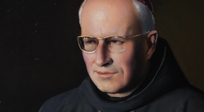
Dom Jean PROU
Born in 1911, was procurator in Curia, i.e. chargé d'affaires of the Solesmes Congregation in Rome, when he was elected abbot on 5 July 1959. In 1961, he made a foundation in Keur Moussa, Senegal. The monks of Keur Moussa were soon joined by nuns from Sainte-Cécile, who founded the neighbouring monastery of Keur-Guilaye.
Dom Prou attended the Second Vatican Council in his capacity as Abbot President of the Solesmes Congregation. He was especially involved in drawing up the conciliar texts on the liturgy. His years spent in Rome and the remarkable ecclesial experience of the Second Vatican Council made a deep impression on Dom Prou, enabling him to steer our community and the entire Solesmes Congregation safely through the Aggiornamento period following the council. In accordance with the council’s stipulations, this involved adapting monastic life to today’s world while remaining completely faithful to St Benedict’s founding inspiration.
Dom Prou resigned in 1992 and died at Solesmes on 14 November 1999. His motto was Coram ipso (In His Presence), which expressed his deep desire to see God.
Dom Jean PROU
Born in 1911, was procurator in Curia, i.e. chargé d'affaires of the Solesmes Congregation in Rome, when he was elected abbot on 5 July 1959. In 1961, he made a foundation in Keur Moussa, Senegal. The monks of Keur Moussa were soon joined by nuns from Sainte-Cécile, who founded the neighbouring monastery of Keur-Guilaye.
Dom Prou attended the Second Vatican Council in his capacity as Abbot President of the Solesmes Congregation. He was especially involved in drawing up the conciliar texts on the liturgy. His years spent in Rome and the remarkable ecclesial experience of the Second Vatican Council made a deep impression on Dom Prou, enabling him to steer our community and the entire Solesmes Congregation safely through the Aggiornamento period following the council. In accordance with the council’s stipulations, this involved adapting monastic life to today’s world while remaining completely faithful to St Benedict’s founding inspiration.
Dom Prou resigned in 1992 and died at Solesmes on 14 November 1999. His motto was Coram ipso (In His Presence), which expressed his deep desire to see God.
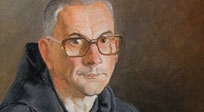
Dom Philippe DUPONT
Born in 1946, was elected abbot on 2 October 1992. His motto is Quae sursum sunt sapite (Savour the Things that are Above [Col 3: 2]), which demonstrates his firm commitment to Solesmes' contemplative monastic ideal. At his request, the process for Dom Guéranger's beatification was opened by the Bishop of Le Mans.
In 1997, Dom Dupont founded a monastery in Lithuania, sending a dozen monks of Solesmes to Palendriai. This new monastic church was consecrated on 7 June 2002.
Dom Philippe DUPONT
Born in 1946, was elected abbot on 2 October 1992. His motto is Quae sursum sunt sapite (Savour the Things that are Above [Col 3: 2]), which demonstrates his firm commitment to Solesmes' contemplative monastic ideal. At his request, the process for Dom Guéranger's beatification was opened by the Bishop of Le Mans.
In 1997, Dom Dupont founded a monastery in Lithuania, sending a dozen monks of Solesmes to Palendriai. This new monastic church was consecrated on 7 June 2002.




